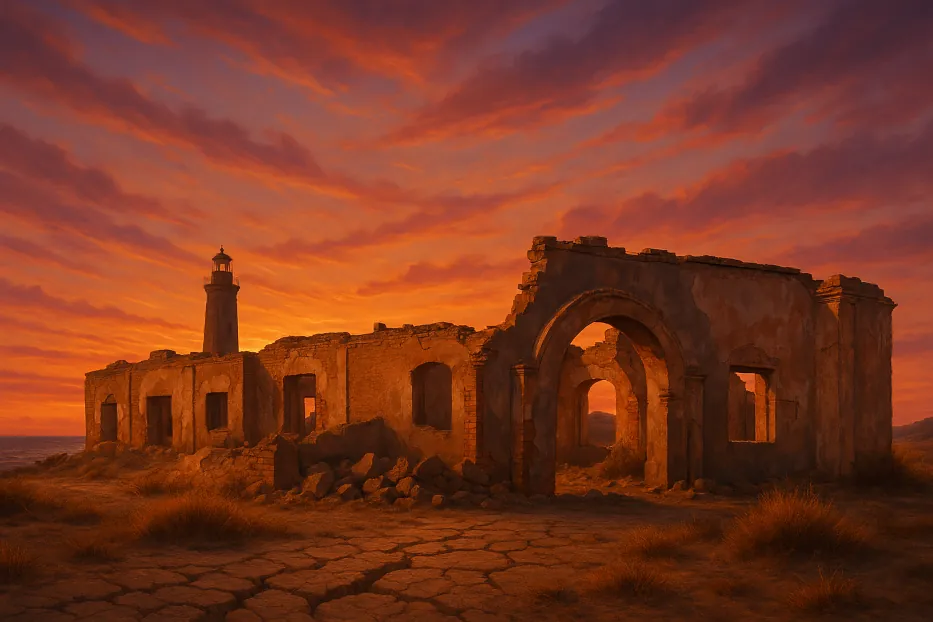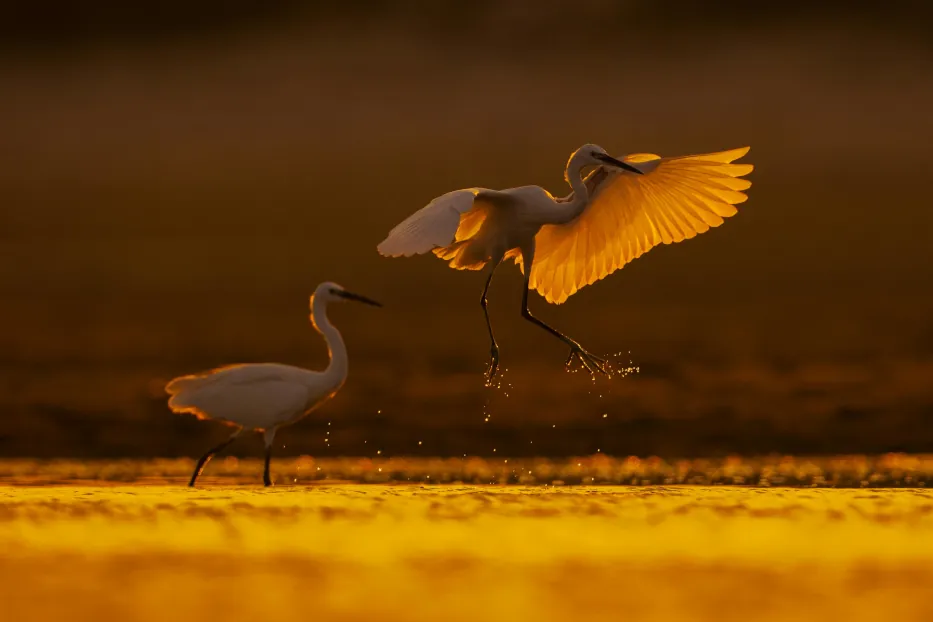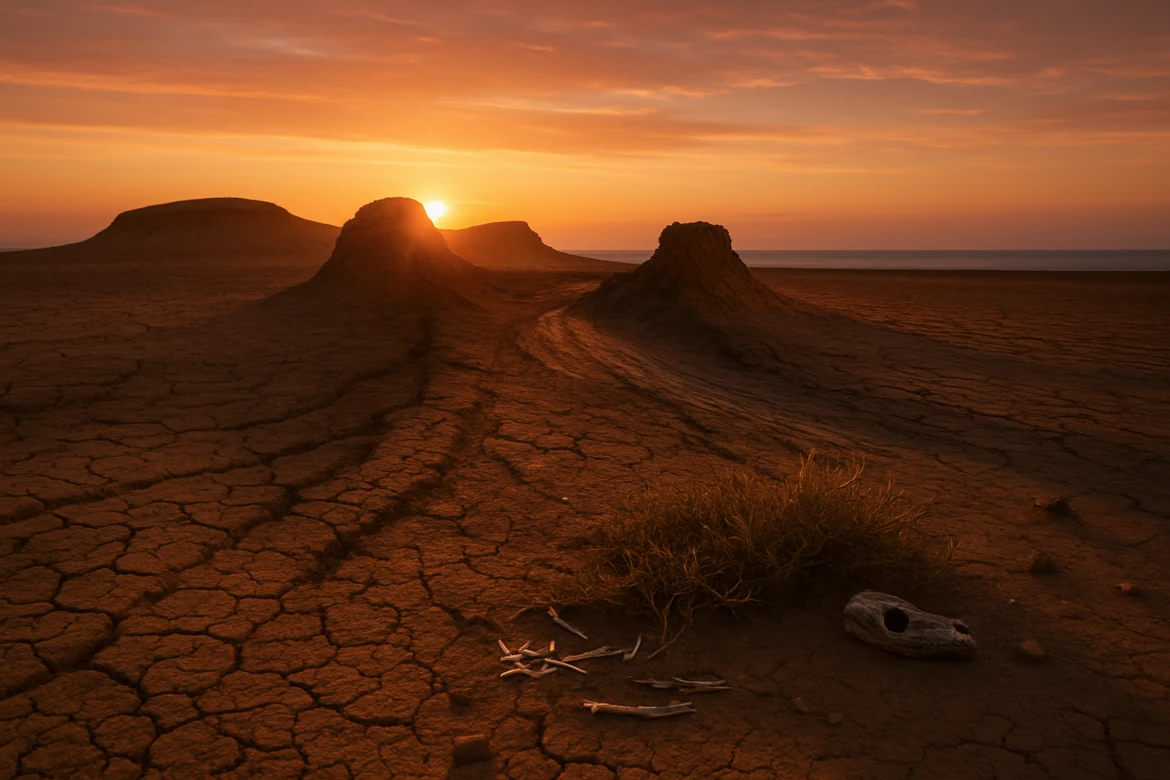Off the eastern coast of Azerbaijan, beyond the mirrored high-rises of Baku and the sunburned hills of Absheron, a strange world begins to flicker into view. It appears first as a shimmer on the horizon: low and broken lines that could be mirages, or oil rigs, or something else entirely.
These are the islands of the Baku Archipelago: an enigmatic scatter of more than thirty landforms—some islands, others little more than shoals, salt domes, or smoldering mud volcanoes—spread across the Caspian Sea like forgotten punctuation marks in a story still being written. They are unclaimed by time, remote even in proximity, and for most Azerbaijanis, they exist more in myth than in memory.
And yet, here, within sight of the capital’s neon glow, lies one of the country’s most compelling, mysterious, and least understood landscapes. Despite their proximity to Azerbaijan’s bustling capital, there are no permanent settlements on the islands. People only travel here briefly, either for the purpose of scientific research or for the relentless pursuit of oil.
Table of Contents
The Caspian
The Caspian has always been more than a sea. To geologists, it is the world’s largest inland body of water—technically a lake, but one with the temperament of a sea and the salt to prove it. To traders, it was once a corridor of silk, spice, and conquest. And to Azerbaijan, the Caspian is a mirror that reflects both its natural beauty and its industrial backbone.
Within this ancient basin, the Baku Archipelago unfurls in crooked geometry, stretching southeast from the Absheron Peninsula toward the horizon. Each island’s name tells a story, sometimes more than one. Some names come from Turkic languages, others from Persian, Russian, or were given during Soviet times. Today, each of these islands also has an Azerbaijani name.
Few travelers visit these islands, and even fewer appreciate the full history and significance of what they see.

Boyuk Zira: The Ghost of Empires
The most famous—and infamous—of these islands is Boyuk Island, formerly known as Nargin. At first glance, it seems like nothing more than a parched hunk of rock, swept by winds and bleached by the sun. But this island holds shadows deep enough to rival its crumbling cliffs.
During the First World War, Boyuk Island was transformed into a prison camp by Russian forces. Thousands of Turkish soldiers (many of them captured during the Battle of Sarikamish) were ferried here under false promises of exchange. They arrived weak, frostbitten, and starving. They died in silence, their graves unmarked and later swallowed by time. Soviet authorities continued using the island as a place of exile and isolation, eventually militarizing it fully. For decades, it became invisible—erased from public maps, cordoned off, and patrolled by ships.

Today, though still restricted, Boyuk Island is visible again. Its skeletal lighthouse still stands. The rusted foundations of old barracks and a Soviet radio tower cling to the rock. From the promenade of Baku, on clear mornings, its jagged profile pierces the haze—a haunted punctuation on the Caspian’s edge.
Between Oil and Eternity
Few places in the world see natural wonder and industrial ambition clash as vividly as in the Caspian waters off Baku. Beneath these restless waves lies one of Earth’s richest petroleum reserves, and for over a century, this sea has been a theater of oil fever, sacrifice, and transformation.
Some islands were consumed entirely by that hunger. Though not part of the Baku Archipelago proper, Pirallahı Island, just to the east, played a pivotal role in Azerbaijan’s oil saga. It was here that some of the country’s first wells were hand-dug in the 19th century. Later, Soviet engineers carved canals through its rocky core and built causeways to transport equipment, often braving corrosive salt winds and Caspian storms in pursuit of black gold.
Even farther out, the horizon yields to the surreal: Neft Daşları, or “Oil Rocks,” a sprawling offshore city balanced on stilts above the sea, built in 1949. Though technically outside the archipelago’s bounds, it embodies the region’s evolution: a Soviet-age dreamscape of scaffolding and flame, where the quest for oil reshaped the seascape itself.
But in this strange, in-between world, oil rigs aren’t the only things that burn; conflicts, too, are ignited in the pursuit of wealth.
The Living Earth
The Baku Archipelago is also home to some of the world’s most active mud volcanoes. These are not the fiery infernos of Hawaii or Iceland, but subterranean cauldrons of gas and clay, erupting with a kind of oily rage. On islands like Qara Su and Gil Island, the ground can tremble with sudden pressure; black sludge boils to the surface; in rare instances, blue flame bursts into the air, burning with no visible fuel.
These eruptions are neither predictable nor controllable. They occur when the earth’s buried gases: methane, ethane, carbon dioxide—reach critical mass beneath the surface and break free, often accompanied by explosions and temporary flames that can be seen for miles.
For Azerbaijani poets and scientists alike, these volcanoes are symbolic: an unquiet earth, breathing, shifting, remembering.
The Sanctuary of Birds
Despite all the violence—natural and manmade—the archipelago is not without gentler rhythms. It is, in fact, a vital node in the Caspian flyway, a migratory route used by thousands of birds traveling between Siberia, Central Asia, and Africa.
In spring and autumn, the islands become temporary havens for flamingos, pelicans, herons, gulls, and rare Caspian terns. The shallows around Chilov and Qum Island teem with life, and even the wind-scorched Xara Zira sees brief moments of grace as egrets stalk through tidal pools beneath a rust-colored sky.

Local environmentalists have begun quiet efforts to catalog and protect this fragile biodiversity. But they face an uphill struggle: many of the islands are inaccessible, polluted, or threatened by further development.
Myths Carried by the Wind
In the villages of Absheron, old men still speak of the islands with a peculiar mix of reverence and fear. Some say the islands are inhabited by spirits—djinns, blown across the sea by the “shai-tan wind.” Others recall stories of cursed sailors, of islands that disappear in fog and reappear in different places, of lights that flicker where no lighthouse ever stood.
There are whispers that Stepan Razin, the infamous 17th-century pirate, used Duvannı Island to divide his loot. That on Gil Island, people hear voices when no one is there. That Chilov, long abandoned, still plays host to something watching from beneath the waves.
True or not, these stories feel right here. They match the geography: a landscape that feels isolated, uncanny, and charged with forgotten stories.

A Place Between Worlds
The Baku Archipelago is neither fully sea nor fully land. It is neither sanctuary nor ruin. It is a contradiction—a liminal space, shaped by the unpredictable push and pull of nature, empire, and industry. It is both a witness and a warning.
Today, there is talk, still tentative, of opening some of the islands to eco-tourism and conservation, of creating low-impact infrastructure for scientists, birders, and storytellers. But the Caspian is capricious. Winds rise quickly. Moods shift.
The archipelago waits, caught in that restless silence between memory and myth, a place that seems determined to remain wild even as the world around it moves on.
The 5 Largest Islands in the Baku Archipelago
| Island Name | Area (hectares) | Area (acres) | |
|---|---|---|---|
| 1 | Xara Zira (Xərə Zirə) | 350 | 865 |
| 2 | Boyuk Island (Böyük Zirə) | 140 | 345 |
| 3 | Gil Island (Gil adası) | 90 | 222 |
| 4 | Sangi-Mugan Island (Səngi Muğan) | 50 | 123 |
| 5 | Chikil (Çigil) | 40 | 99 |

